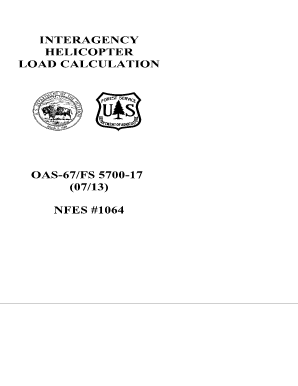
Get Interagency Helicopter Load Calculation 2020-2025
How it works
-
Open form follow the instructions
-
Easily sign the form with your finger
-
Send filled & signed form or save
How to fill out the Interagency Helicopter Load Calculation online
The Interagency Helicopter Load Calculation is a critical document for ensuring safe and efficient helicopter operations. This guide provides a clear, step-by-step approach to completing the form, enabling users to accurately capture essential information regarding their flight operations.
Follow the steps to effectively complete the Interagency Helicopter Load Calculation
- Press the ‘Get Form’ button to access the Interagency Helicopter Load Calculation form and open it in the corresponding editing interface.
- Fill in the model number and pilot(s) names, followed by the date, mission type, and time of flight.
- In the departure section, enter the name of the departure location and current pressure altitude (PA) as well as outside air temperature (OAT) at the departure location.
- Next, provide the destination information including the name and both PA and OAT at the destination. If you are unsure of the destination conditions, estimate using MSL elevation from a topographic map.
- Input the helicopter equipped weight which includes the empty weight plus lubricants and necessary onboard equipment.
- Enter the flight crew weight, which should include the total weight for the pilot and any other crew members along with their personal gear.
- Calculate and fill in the fuel weight by multiplying the number of gallons of fuel by its weight per gallon.
- Compute the operating weight by adding the equipped weight, flight crew weight, and fuel weight together.
- In the performance reference section, provide details on the performance charts used to determine the computed gross weight.
- Calculate the computed gross weight using the necessary performance charts, selecting the most restrictive PA and OAT.
- If applicable, determine the weight reduction needed for non-jettisonable loads.
- Subtract the weight reduction from the computed gross weight to determine the adjusted weight.
- Reference the gross weight limitation section of the flight manual to fill in the maximum allowable weight for the helicopter.
- Select the lowest weight value entered previously as the selected weight.
- Re-enter the operating weight as determined in step 8.
- Calculate the allowable payload by subtracting the operating weight from the selected weight.
- Detail the passenger and/or cargo manifest including weights and descriptions for all carried items.
- Sum up the actual payload, ensuring that it does not exceed the allowable payload established in the previous steps.
- Both the pilot and helicopter manager must review the completed document and provide their signatures.
- Indicate whether hazardous materials are being transported and specify their details accordingly.
Complete the Interagency Helicopter Load Calculation online now to ensure your flight adheres to safety standards.
Getting a load calculation involves assessing the helicopter's weight, payload, fuel quantities, and environmental conditions. You can perform these calculations manually or use specialized software. The Interagency Helicopter Load Calculation offers a reliable method to ensure these calculations are performed correctly, enhancing safety and efficiency in aerial operations.
Industry-leading security and compliance
-
In businnes since 199725+ years providing professional legal documents.
-
Accredited businessGuarantees that a business meets BBB accreditation standards in the US and Canada.
-
Secured by BraintreeValidated Level 1 PCI DSS compliant payment gateway that accepts most major credit and debit card brands from across the globe.


